The history of the Greenlandic dog extends back as much as 4000 years. Greenlandic dogs originated from the Asian continent and were brought over by the Inuit population over 1000 years ago. The dog breed found in Greenland today is believed to be one of the most isolated and pure dog breeds in the world and no interbreeding with other breeds of dogs is allowed.
For the past two field seasons at Kap Hoegh, and for this third and final season, dogs have been hired in order to provide a early warning and first defense against the forever looming possibility of an encroaching polar bear.
Last year Ann rented Abe, our Greenlandic ‘bear’ dog, from NANU travel. He was reported to be the best, fiercest bear dog in the village. "Abe is quite tolerant with humans, but don’t expect warmth from that one.”
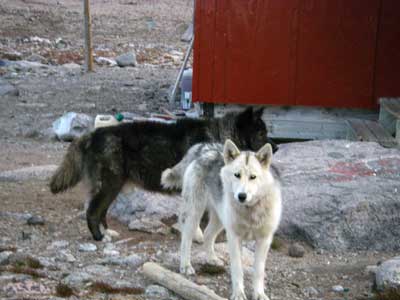
Abe’s girlfriend is out front, Tyr.
That comment from Martin, his owner was matter-of-factly stated to a team of Europeans that had been raised with a succession of loyal, gentle, indoor/outdoor canines, considered pets. Abe had not been, and never would be, a pet, he was a working dog, like all the others in this community. The owners comment was remembered while setting up the field camp and the team, perhaps subconsciously, began to work on Abe. They may have considered that comment; and wondered, "Was that an invitation for change? Or a challenge?”
You will rarely hear a bark from a Greenlandic dog, but can often hear a howl, left from their ancestral roots that intertwined with Arctic wolves. In Greenland dogs are not pets, they are employees. Their adult lives consist of eating, sleeping, breeding and pulling. These dogs are able to pull one and one-half times their own weight, for great distances. As animals that work as a pack, one is always dominant, with the others waiting for a chance to establish control. They are also friendly and are happy to get human attention, but do not commonly establish deep bonds.
Puppies freely frolic around their homes this time of year. Glancing at many front porches, a dark, leathery square nose tip will pop out, followed by a bounding ball of fur.
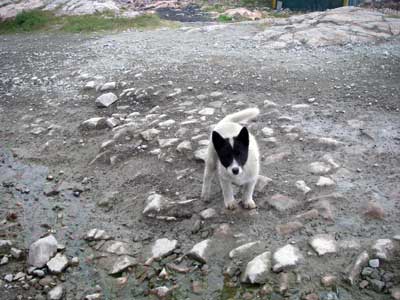
*All fur, feet, and fun, this puppy wants love. *
They do not seem to stray far from the home, for if mom stays close to the house, they will plan to be ready for a meal. Beginning at 6 months old all dogs, except nursing females, must be chained at all times. This regulation is country wide. Several dog teams can be seen chained all over the village.
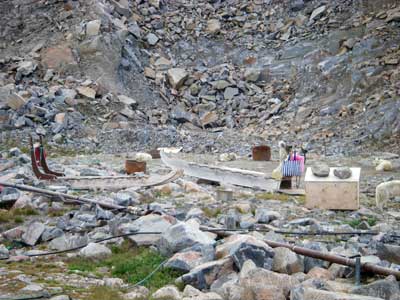
Bored, but resigned to the summer; these dogs wait for the exercise a snowfall will bring them.
Periodically, free roaming adult dogs discovered by the visiting dog hunter, will be shot, culled from the population, for they may be ill or abandoned. Where ever I see a tethered team, it is easy to notice some appear to be uncared for. But as I read up on these powerful canines, I learned that in the summer, the thick, dense winter fur is replaced by a thinner coat. When the animals are not groomed consistently, winter fur drops off in patchy tufts, giving a shabby uncared for look. Comments about canine health have certainly been made by me and some of my walking companions. Now I now have a more educated understanding. The following has been emphasized to me by the Travel Agency where the dogs were hired from; the Greenlandic dog is a working animal and is treated like that by their owner. This means they sleep out all year; they are not taken out for a walk when they are chained during summertime, and when they’re too old to work, normally around the age of 8 - 9 they’re shot. This seemingly harsh treatment is what this culture has established. This method works for the community; they accept it and live by it. The animals are not their pets, but they are well cared for. The hunter has an obvious interest in the well being of his dogs, as he depends on their strength to pull the sled. Mistreatment is not accepted, and may cause an entire team to be confiscated.
Abe has been raised to be such a Greenlandic dog. He had been the dominant member of his sledge team, until age began to slow him down. His owners had a soft spot for him, so have kept him as company for longer than most. They were delighted to rent him out, since they knew of his skills and senses. Last August, when he was returned, his owner expressed dismay at the dog that was returned. "This is not the same dog; this dog seeks nurturing, affection and wants human touch. What have you done to my warrior?”
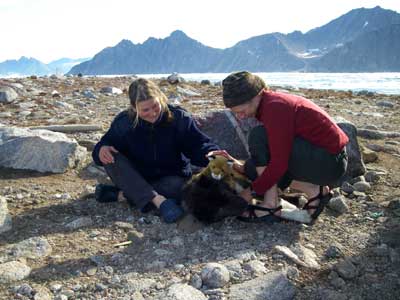 I really can be fierce!!
I really can be fierce!!
Although not exact words, this sentiment was expressed by the owner, Martin, of NANU travel, at the end of the 2006 field season. I have left Kap Höegh now, and Abe is just a teddy bear, hopefully a watchful, alert teddy bear. The team is not looking forward to the comments they will receive as they altered, even more, Abe’s opinion and expectation of humans. We all hope Martin (Abe’s owner) will anticipate the possibility and appreciate the kind, old man that Abe has shown himself to be.
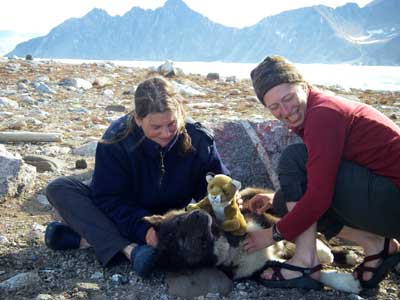 I’m hired, so need to do some hokey things, I am getting paid, you know.
I’m hired, so need to do some hokey things, I am getting paid, you know.
(Just don’t tell my team…please…!!)
Information about Greenlandic dogs obtained from Anders Stenbakken, Destination East Greenland


Comments